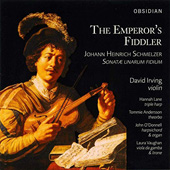
ESSENTIAL RECORDINGS

Austrian violinist and composer Johann Heinrich Schmelzer (c. 1620/1623–1680) was an important musical figure during the Baroque period. To put him in a chronological perspective, Antonio Vivaldi was born the year he died followed by the birth of Johann Sebastian Bach five years later in 1685. During his lifetime he dominated the Viennese music scene as a versatile instrumentalist and prolific composer of sacred works including many Masses and Vespers, and a string of instrumental pieces including the six Sonatæ Unarum Fidium. He was a favorite musician of Emperor Leopold I, and was the first non-Italian appointed Kapellmeister to the imperial court in 1679. Unfortunately, Schmelzer died from the plague one year later.
These Sonatas hold the honor of being the first to be published by a non-Italian composer. They are laid out in a single-movement format, divided into multiple segments, each one demanding various degrees of emotive expression, and various levels of virtuosity from the soloist. They are scored for violin (David Irving), theorbo (Tommie Andersson), Italian baroque triple harp (Hannah Lane), harpsichord and chamber organ (John O'Donnell), and viola da gamba (Laura Vaughan), or at least that's the choice of basso continuo instrumentation used in this recording. What they lack in counterpoint and harmonic diversity, they certainly compensate for with tonal richness in the melancholic passages, and bold and brilliant technique during the more virtuosic segments. There's even a long segment of the Sonata No. 4 written as a passacaglia which resembles Johann Pachelbel's famous Canon. David Irving plays a violin by John Simmers (2000), a replica of a Jacob Stainer (c.1670), using equal-tension stringing, which certainly lends the lower strings a more brilliant and resonant character. The booklet notes contain detailed information on various violin and bow handling techniques that would have been in use during Schmelzer's time.
The recording itself was captured in a church, which lends the audio an excellent presence and soundstage, with just the right level of reverberation and depth perspective. The balance, especially between the organ and violin, couldn't be better. Too many recordings of this type tend to favor the lead instrument at the expense of the rest of the ensemble, but that is not the case here. Highly recommended for anyone interested in discovering the music of one of the composers who set the cornerstone that was to support the mighty edifices of the late Baroque.
Jean-Yves Duperron - October 2018